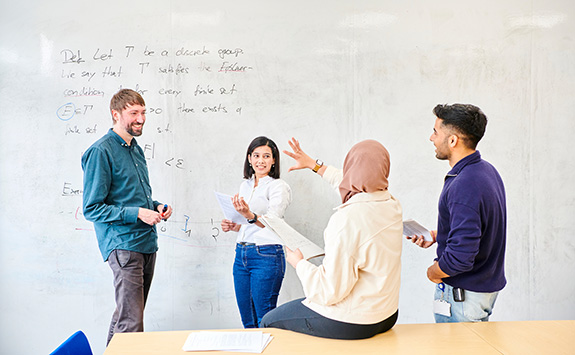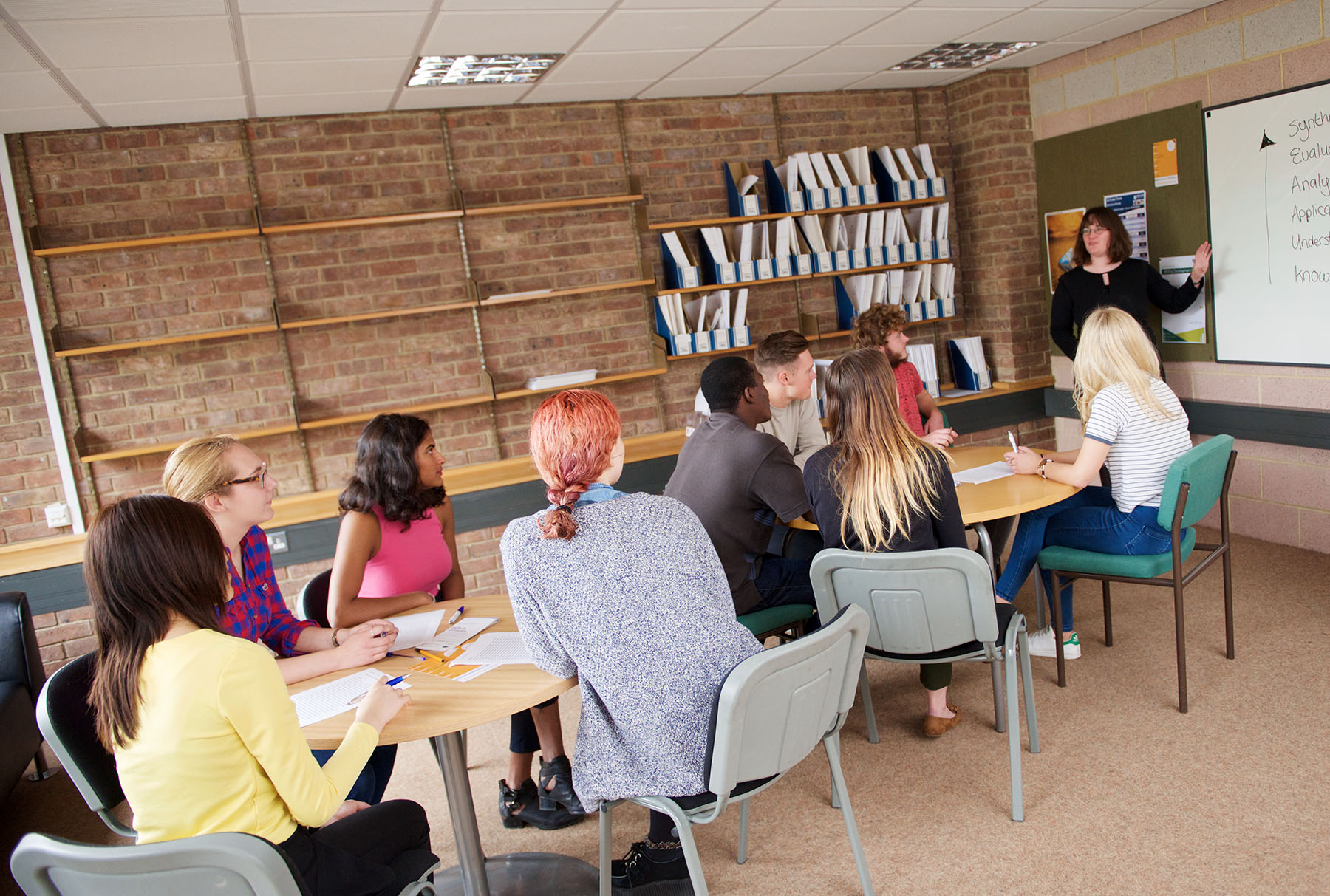Collaborative Projects
NEW: A vision for education and skills at Newcastle University: Education for Life 2030+
Why use collaborative projects in teaching?
Skill development: Collaborative projects help your students to develop essential skills such as communication, teamwork, leadership, and conflict resolution. These skills are crucial for students' personal and professional growth, preparing them for diverse workplace environments. Group projects also encourage active learning and critical thinking, as students engage more deeply with the material, share diverse perspectives, and learn from each other.
Future focused: Group work can also simulate workplace scenarios where teamwork is often essential. By working together, students gain experience in managing group dynamics, meeting deadlines, and achieving common goals, which are valuable skills in any career.
Motivation: Working in groups increases student engagement and motivation (Healey, 2024): the social aspect makes learning more enjoyable and can lead to higher levels of participation and commitment to the task.
Diverse perspectives: Group work also brings together students from different backgrounds and disciplines, encouraging a diversity of ideas, perspectives, and approaches. This diversity can lead to more creative solutions and a broader understanding of complex problems.

Working together
Don’t assume that that students will know how to work together. Providing cohort-wide guidance on team working, etiquette, and inclusion will help to establish expectations. In early stages, allow time for students to learn these skills and provide opportunities for students to reflect on how they can improve their group’s effectiveness. You can also support students to reflect on their own strengths within a team context.
As team projects develop across your programme you may wish to include mechanisms to ensure that students gain a variety of experiences of different roles.
Valuing Diversity
Support students to see diversity as a positive attribute of team working. Student teams will reflect our diverse student population encompassing differences in culture, ethnicity, gender, socio-economic background and academic working level. This variety enhances creativity and innovation, encouraging students to challenge assumptions and consider alternative viewpoints. It also mirrors the realities of modern workplaces, better preparing students for collaborative careers in global industries.
Diverse groups promote the development of key interpersonal and intercultural skills. Students learn to communicate effectively across differences, negotiate meaning, and build mutual respect -- skills that employers increasingly value. From an academic standpoint, diversity can lead to richer discussions, more robust critical thinking, and improved learning outcomes.
Group Task and Outputs
Design interesting and challenging exercises that groups can complete in the time allowed and with the resources available.
Give clear instructions at the beginning of the exercise and monitor progress. Encourage groups to clarify anything that they don't understand. Explain how you'll assess the project and what outputs students need to produce.
Structure
Groups function most effectively when they have milestones to work towards. You can build these into your assessment design or groups can negotiate them by themselves.
Ask groups to keep records of meetings so that all members have a common understanding of tasks in progress, deadlines and responsibilities. When monitoring progress, encourage groups to be sympathetic to each other's circumstances. Offering each other support during the task may be the more effective than getting to a deadline only to find that one member has struggled to complete their assigned work.
Dealing with Conflict
Personality clashes or domineering members can create personal issues within groups. Encourage groups to give all members opportunities to speak at team meetings. Remind them that any group project will require negotiation and compromise.
Unequal contribution has been identified by many as a common issue in groupwork, often this is described as 'freeloading'. However, some group members may be naturally quieter than others. Encourage groups to promote contribution by all members to group discussions and meetings. Each member should be given the opportunity to contribute to discussion and give opinion. Peer assessment and individually assessed components can support you to identify unequal contributions.
Supporting students with additional needs
When you explicitly champion diversity in group work, you create a more inclusive environment where students can participate according to their strengths. You may need to provide simple modifications for individual students or, where these aren't appropriate, alternative assessments. See: Inclusive Assessment: Groupwork
For support and advice with students who have a Student Support Plan (SSP) affecting their ability to contribute to group work, contact Student Health and Wellbeing
Forming groups
You can form groups in several ways, each with its own benefits and drawbacks:
- Self-selection: students choose who they work with. Most students will be happy with the team that they are in, and some students will appreciate the choice to allow them to work with others with whom they feel secure. But the likelihood of diversity is reduced, and there may be some students who have not made connections, leaving them excluded from group dynamics.
- Self-selection by topic: Students choose their team based on a topic or problem to work on that they are most interested in. This has the advantage that students are likely to be more engaged in the topic they select. But it can run into problems if numbers are capped for certain topics, and students do not get to work on their first choice. This approach can also be socially gamed, students choose who they work with and then select the same topic together.
- Random selection: Use an online tool or other means to randomly allocate groups. Leaving group selection to fate like this could have many unforeseen problems such as grouping together those with personal issues or lack of diversity across various characteristics. This may need some sense-checking and tweaking, by which point you may as well have allocated the groups yourself.
- Teacher allocation: You select the groups, deliberately creating diverse groups with a spread of interests, strengths, and abilities. You may still run into personality clashes that you did not know about, but even this can still be embraced positively as the students learn to work together.
- Hybrid/partial self-selection: Students group themselves at about half the size of the project team, and you pair these groups up to make full teams that are more diverse. This gives a good spread of diversity and cohesion, although the groups could still see some division and disharmony between the two halves.
Allocating groups yourself seems to be the most popular approach among colleagues, and is largely supported by the literature (University of Sussex, 2024; Ion, G., Díaz-Vicario, A., & Mercader, C. (2023), for example).
The only real drawbacks might be the time it takes to allocate the groups, and that the students may not like the group they have been put into. Learning how to deal with this is arguably an essential life skill: when students start in our new workplace, we cannot choose our colleagues and will need to learn about how they work and how to adapt.
What to assess: product or process or both?
You can opt to assess the output the group produces (product), the teamworking and problem solving involved during the group working (process), or a combination of these. Your intended learning outcomes should guide your approach, along with the relevance of skill development and reflection for your students at their stage of learning.
- Assessing the product only: this approach disadvantages groups that work and learn well together but fail to produce the desired output; similarly a group could produce a strong output without effective teamwork
- Assessing the process only: this can encourage greater creativity and reward groups that develop strengths in negotiation and problem solving, but requires careful thought on how students should collate and reflect on their working.
- Assessing a combination of product and process gives the potential for teams to be rewarded for their collaboration and the quality of their output.
Including and individual component
Students often perceive group assessment as unfair (Sambell et al., 1997), particularly when non-contributing members receive the same marks as engaged participants. To address this concern, design assessments that enable students to clearly identify individual contributions within their projects.
One effective approach combines group assessments with individual summative components—such as reflective essays or examinations that contribute a percentage of the module credit. These individual elements can either relate directly to the group task or assess broader learning outcomes independently.
Evaluating individual contributions with peer assessment
While you might attempt to gauge individual contributions through observations, meeting records, or discrete task elements, group members themselves provide the most authentic evaluation. As Healey (2024) notes, students are uniquely positioned to assess their group's effectiveness and each member's contribution level—they alone have complete insight into the group's internal dynamics.
You can use peer assessment to evaluate contributions to group work, with results informing individual marks:
- The peer assessment generates individual adjustment factors, which are then used to multiply the group mark. High performing group members receive scores higher than the group mark, those who made limited contributions will receive less than the group mark.
- The peer assessment is used to generate a small range of marks added to the group mark.
While students can negotiate peer assessment (eg splitting 100 marks between themselves), you will more commonly run this as an anonymous process using submitted forms or a tool like Buddycheck tool in Canvas.
Cautions
- Student evaluation of their peers could be open to biases and subjectivity. You need to carefully moderate and oversee the allocation of final marks.
- Carefully consider the weighting you attach to peer assessment - if this is too high it may foster competition and be counterproductive.
See Guidance on Group Work with Peer Assessment for further details.
References
- Ion, G., Díaz-Vicario, A. & Mercader, C. (2024) ‘Making steps towards improved fairness in group work assessment: The role of students’ self- and peer-assessment’, Active learning in higher education, 25(3), pp. 425–437. Available from the Newcastle University Library.
- Healey, M. (2024). Enhancing Working in Groups and Teams in Learning and Teaching in Higher Education: A Report for the Centre for Education Teaching Innovation, University of Westminster, UK. Available at: https://www.researchgate.net/publication/382524135_Enhancing_Working_in_Groups_and_Teams_in_Learning_and_Teaching_in_Higher_Education_A_Report_for_the_Centre_for_Education_Teaching_Innovation_University_of_Westminster_UK.
- Sambell, K., McDowell, L. & Brown, S. (1997) ‘“But is it fair?”: An exploratory study of student perceptions of the consequential validity of assessment’, Studies in educational evaluation : SEE., 23(4), pp. 349–371. Available from the Newcastle University Library.
- University of Sussex (2024). Making Group Work Inclusive. Accessed 17/07/2025. Available at: https://blogs.sussex.ac.uk/learning-matters/2024/10/17/making-group-work-inclusive/.
